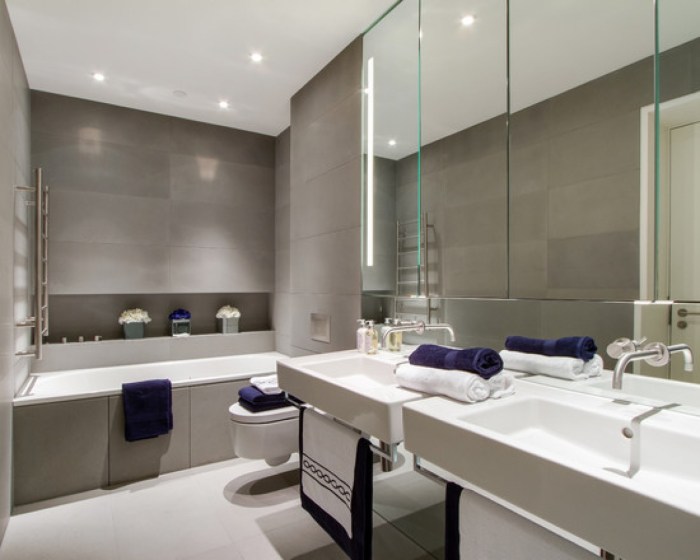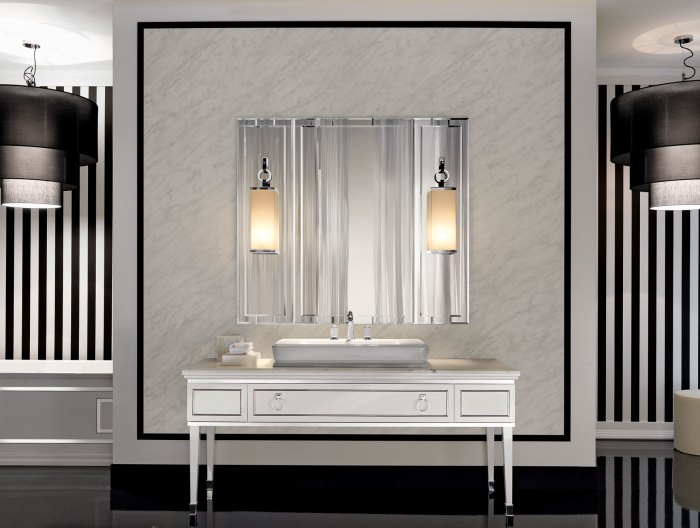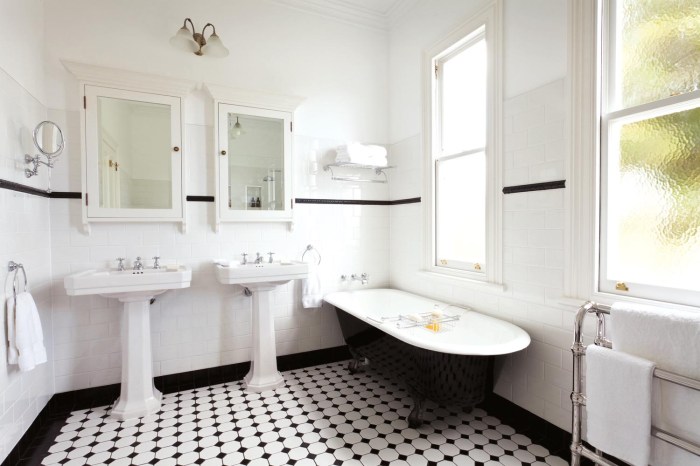Step into the glamorous world of Art Deco, where geometric patterns, rich colors, and exquisite details converge to create bathrooms that exude elegance and sophistication. Inspired by the roaring twenties and the allure of the Art Deco era, these tiles bring a touch of timeless style to your private sanctuary.
In this comprehensive guide, we delve into the captivating world of Art Deco-inspired bathroom tiles, exploring their design principles, material considerations, and the impact of lighting and fixtures. Prepare to be mesmerized as we unveil the secrets of creating a bathroom that is both visually stunning and functionally exceptional.
Design Inspirations
Art Deco, a glamorous and sophisticated style that emerged in the 1920s, is characterized by its bold geometric patterns, rich colors, and luxurious materials. Its aesthetic principles can be seamlessly incorporated into bathroom tile designs, creating elegant and visually striking spaces.Art
Deco bathroom tiles often feature geometric patterns such as chevrons, zigzags, and sunbursts, which add a sense of dynamism and movement to the space. The use of contrasting colors, such as black and white or gold and emerald green, creates a striking and sophisticated look.
Additionally, Art Deco-inspired tiles may incorporate metallic accents or mirror inserts, adding a touch of glamour and opulence.
Examples of Successful Applications
Successful Art Deco-inspired bathroom tile applications can be found in both residential and commercial settings. In a private residence, Art Deco tiles can be used to create a luxurious and inviting master bathroom, featuring a geometric tile floor and a mosaic tile accent wall.
In a hotel or restaurant bathroom, Art Deco tiles can add a touch of elegance and sophistication, creating a memorable and visually appealing space for guests.
Material Considerations
When selecting tiles for an Art Deco-inspired bathroom, consider the following materials:
Ceramic Tiles: Durable and cost-effective, ceramic tiles offer a wide range of colors, patterns, and finishes. However, they may chip or crack more easily than other materials.
Porcelain Tiles
Similar to ceramic tiles but denser and less porous, porcelain tiles are more resistant to moisture and stains. They come in a variety of styles and are a good choice for high-traffic areas.
Glass Tiles
Glass tiles create a luxurious and shimmering effect. They are non-porous and easy to clean but can be more expensive and prone to scratching.
Natural Stone Tiles
Natural stone tiles, such as marble or granite, add a touch of elegance and durability. However, they require sealing to protect them from stains and moisture.
Size, Shape, and Texture
Choose tiles in sizes and shapes that complement the bathroom’s dimensions and style. Rectangular tiles are a classic choice, while square or hexagonal tiles can create a more contemporary look. Textured tiles add visual interest and can help conceal imperfections in the walls or floor.
Color and Pattern
Color plays a pivotal role in Art Deco design, adding a distinctive touch of glamour and sophistication to bathroom tiles. Common color palettes for Art Deco-inspired tiles include rich hues such as emerald green, cobalt blue, and burgundy, complemented by metallic accents of gold, silver, and bronze.
Color Combinations
Effective color combinations for Art Deco tiles often involve contrasting shades, such as black and white, or bold colors like red and gold. Geometric patterns, such as zigzags, chevrons, and sunbursts, add a dynamic element to the design. These patterns can be created using contrasting colors or by incorporating metallic accents.
Geometric Elements
Geometric shapes, such as rectangles, triangles, and chevrons, are fundamental to Art Deco style. These shapes create a sense of order and symmetry, and they can be used to create visually striking patterns. In bathroom tiles, geometric patterns can be used to add visual interest and to create a variety of different looks.
Incorporating Geometric Elements
There are many different ways to incorporate geometric elements into tile designs. One popular approach is to use a single geometric shape as the basis for the pattern. For example, you could use rectangular tiles to create a classic subway tile pattern, or you could use triangular tiles to create a more modern look.
Another approach is to use a combination of different geometric shapes to create a more complex pattern. For example, you could use a combination of rectangles and triangles to create a checkerboard pattern, or you could use a combination of chevrons and hexagons to create a more abstract look.
Decorative Details
Art Deco-inspired bathroom tiles embrace decorative details that elevate the overall design and create a sense of luxury. These elements add visual interest, depth, and sophistication to the space.
Borders, inlays, and mosaics are commonly used to enhance the aesthetic appeal of Art Deco tiles. Borders frame the tiles, creating a distinct separation between different sections or colors. Inlays involve the insertion of smaller tiles or decorative elements within the main tile surface, resulting in intricate patterns and designs.
Mosaics, composed of small, individual tiles, offer endless possibilities for creating unique and eye-catching compositions.
Examples of Decorative Elements
- Metallic Accents: Gold, silver, or brass accents can add a touch of glamour and opulence to Art Deco tiles.
- Geometric Patterns: Zigzags, chevrons, and other geometric patterns are hallmarks of Art Deco design and can be incorporated into tile borders or inlays.
- Floral Motifs: Stylized floral patterns, such as stylized lilies or palm leaves, add a touch of organic beauty to Art Deco tiles.
- Mirror Inlays: Small mirror inlays can reflect light and create a sense of spaciousness, adding a touch of drama to the bathroom.
- Glass Tiles: Glass tiles in various colors and textures can be used to create shimmering mosaics or accentuate borders.
Lighting and Fixtures
Lighting plays a pivotal role in shaping the ambiance of an Art Deco-inspired bathroom. It accentuates the intricate tile designs and creates a luxurious and sophisticated atmosphere.The choice of lighting fixtures should complement the Art Deco aesthetic. Geometric chandeliers with sharp angles and streamlined shapes are classic options.
Wall sconces with frosted glass or metallic accents add a touch of glamour.For task lighting, vanity mirrors with integrated LED lights provide ample illumination for grooming. Recessed ceiling lights or track lighting can be used for general illumination, while accent lighting can highlight specific architectural features or artwork.
Final Summary
As you embark on your Art Deco bathroom transformation, remember that these tiles are not mere decorative elements; they are an investment in timeless elegance. Their durability, versatility, and aesthetic appeal ensure that your bathroom will remain a source of pride and admiration for years to come.
Embrace the spirit of Art Deco and create a space that reflects your discerning taste and appreciation for the finer things in life.



